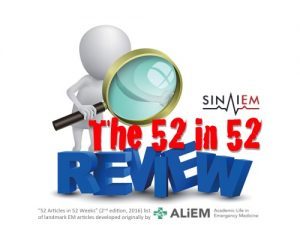Brief Note: This article is a methods-only paper. The results of the Nexus study will be discussed in next week’s 52-in-52 Pearl.
Article Citation: Hoffman JR, Wolfson AB, Todd K, Mower WR. Selective cervical spine radiography in blunt trauma: methodology of the National Emergency X-Radiography Utilization Study (NEXUS). Ann Emerg Med. 1998 Oct;32(4):461-9. PMID: 9774931
What We Already Knew about the Topic: At the time of publication (1998) the US performed 800,000 plain film cervical spine radiographs, many for blunt trauma. No reliable decision aid had yet been validated to avoid obtaining imaging for low-risk patients. The Canadian C-spine rules paper would not be published for 3 years. A few small prospective studies had suggested a cluster of criteria that might indicate a low-risk patient in whom no imaging would be necessary prior to discharge.
Why This Study is Important: This study, and its sibling (Canadian C-spine rule) have enabled clinicians to avoid subjecting many thousands of patients to neck radiography for low-risk injuries and presentations. Every time you “clinically clear” a patient’s c-spine, you have this paper in part to thank.
Brief Overview of the Study: This study was designed as a prospective, multi-site, observational study. Patients meeting inclusion criteria (blunt trauma and receiving C-spine imaging) were to have four questions about them answered by the treating physician before the films would be taken. The physician was asked to identify (1) Altered neurologic function including AMS (2) Clinical intoxication (3) Midline posterior bony cervical tenderness, and (4) the presence of a distracting injury. Results did not effect imaging plans. All imaging was at the discretion of the physician based upon their prior training. Patients were enrolled only after the physician decided to image. The authors calculated that to obtain a sensitivity of 99.5% with an estimated (conservative) c-spine fracture rate of 2% among blunt trauma victims would require 42,700 patients to be enrolled in the trial.
Limitations: (1) The authors do not attempt to disting\
uish clinically significant fractures from all fractures. At times they use the word fractures, and at other times “injury”, suggesting that were a ligamentous injury to be identified it might be included. (2) No gold standard was used. Though CT imaging was included if it was obtained, most patients would be expected to have a negative plain film as their final definitive imaging test. (3) Image adequacy would not be assessed by the study group. (4) Patients who do not receive imaging (based upon clinician discretion) would not be included in this study, regardless of whether they would have screened “positive” according to the NEXUS criteria.
Take Home Points: The NEXUS study was a prospective cohort study to evaluate whether the four NEXUS criteria could demonstrate an adequately high sensitivity and negative predictive value for c-spine fractures (using plain films at the primary diagnostic medium) to be used to clinically pre-screen patients. Stay tuned next week for the results…

